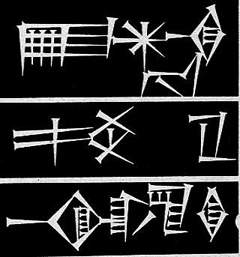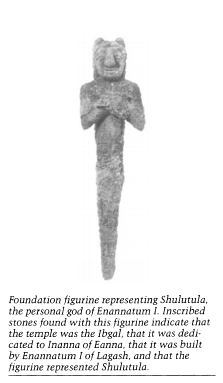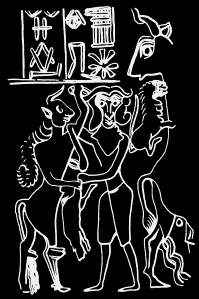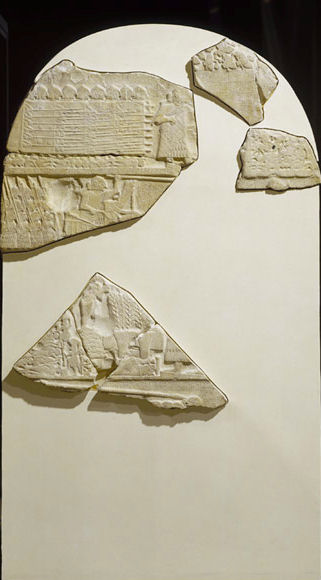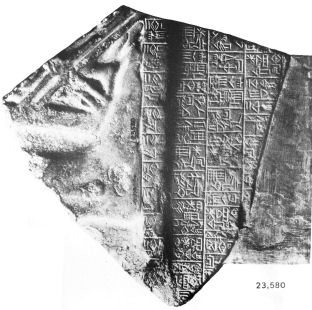Eannatum
Eannatum, Ensi of Lagash
"Nin-Girsu(k) implanted the seed of E-Anna(k)-tum in the
womb and Nin-hursaga(k) bore him.
Personal God
(edition from Vaughn 1977 (2))
(Findspot: N540.w99), Locus 33, Level 11Bfill.
Additional notes: firsts Royal Inscriptions of Eannatum as First Grammatical Texts
First attempt at Coalition Nissen (4) states that as far as attempts at a supreregional political alliance "the first known attempt of this kind was made by Eannatum of Lagash, who was gradually able to draw all the cities of Babylonia, even Mari on the middle Euphrates outside Babylonia, into his sphere of influence, at least for a short time. Although very little is known about the details, we do find from inscriptions that toward the end of Eannatum's reign his sphere of influences had shrunk back to its original size." Eannatum in War
As we know from an inscription of Eannatum's Nephew, Entemena, the rulers of the first dynasty of Lagash relied on the authority of an outside king who had lived some time before Ur-Nanshe in order to maintain their advantageous hold on the Guedina, the fertile lands between Umma and Lagash. (This king of Kish, Mesalim by name, had arbitrated in the dispute between the two lands - for more on Mesalim, please refer to our entry elsewhere on the site.) While Mesalim's edict held for a time, the inscription of Entemena states that (most likely just before Ur-Nanshe's reign) Ush, a ruler of Umma, uprooted the stele of Mesalim and occupied the Guedinna. It was not until the time of Ur-Nanshe's grandson, Eannatum, that the Lagashites responded to this infraction militarily.
- Eannatum's first military priority was to restore the boundary between he home state and Umma that had been established long ago. He attacked and defeated the Ummaites and made a new treaty with Enakelle then the ruler of Umma. Eannatum's Stele of Vultures (see detail below) commemorates this victory and documents the oath or treaty he extracted from the Ummaites. He set a strip of no-man's land on the Umma side of the border for further protection, and allowed the Ummaites to farm some of the fertile fields though part was to be paid as tribute to Lagash. Kramer also tells us that Eannatum restored the Mesalim Stele, and he built numerous shrines to important gods in order to deter any future hostility. An example of the type of warning that may have been present on these shrines or on steles nearby is found on an inscribed mortor of Eannatum, which states that for anyone intending harm: "before the face of Nanshe his personal god shall not walk, nor shall he walk." (Ean. 62, see CDLI P222461, Th. Jacobsen 1976 n. 285) - Eannatum next followed up his victory by attacking Elam, an age old threat to Sumer, at their then capital city, Susa. He next swung south, attacked and defeated Uruk and Ur and won control of all Southern Babylonia (sometimes considered the first attempt at a coalition of states as mentioned above). Inscriptions indicate Eannatum "destroyed Mari" which indicates his force penetrated an impressive span westwards. Finally, Eannatum invaded and subdued Kish to the north, as well as engaging and routing a counterattack by nearby Akshak. Kramer writes that at this time Eannatum was a the pinnacle of his power, and he took the title King of Kish which does not directly suggest Kish itself but means sovereignty over Sumer as a whole (see our notes on the kings of Kish ***http://enenuru.net/html/kingsofkish.htm***). It was at this point a brief period of peace followed and Lagash enjoyed the victories of its king.
- As Kramer recounts, the peaceful period was brief. Eannatum hadn't the time to finish peace-time building projects before he was forced to defend Lagash from a new invasion first from the Elamites which he "just barely" repelled; before he could mount a counter invasion agianst Elam, Lagash was attacked by both Kish and Akshak who Eannatum had subdued not long before, but again he successfully repelled the attackers; there followed however a second attack from Elam who were again followed by Kish and Akshak supported with troops from Mari in the far west - amazingly, Eannatum defeated all of his opponents: "in pitched battles fought at the Asuhur, Lagash's eastern boundary, and the Antasurra, its northern boundary." Kramer explains there followed another brief period of peace, however to it is apparent that soon Eannatum was succeeded by his brother Enannatum and because it was not a son to take the throne as would be customary, the author suspects Eannatum died in the battlefield fighting some battle for which we do not have sufficient record. After the lost of their greatest military leader the Lagashites would never quite regain their domineering position.
The Stele of Vultures is Eannatum's most well known relief
and it is famous for visual depictions of the Lagash/Umma border
conflict. The images depicted are of a semi-historic nature
and include scenes of the departure of several army units under
the leadership of the ruler.. the taking of prisoners among
the enemy by Ningirsu, the god of Girsu; the burial of the dead
of Lagash; and vultures carrying away the limbs of dead enemies
which gives the stele its name. (3) The Stele of Vultures Inscription summed in four sections Section a: Divine favors bestowed on Eannatum This section as mentioned above tells of the divine birth of Eannatum specifically he is said to be fathered by Ningirsu and birthed by Ninhursag. Eannatum's full name is given to him by Inanna. Section b: The Treaty of Umma/Lagash This section deals with the time immediately after Eannatum (in his adulthood) had suppressed Umma - the first paragraph relates how Eannatum extracted an oath from the Ummaites to only peruse a certain portion of the fields of Ningirsu and to only take for themselves a certain portion (the rest was tribute to Lagash), and also that the Ummaites will not violate these boundaries nor rip out their steles. This oath which bound the Ummaites is repeated six times, and the Stele records each instance; the wording is nearly the same on each except the oath is sworn to a different deity each time, first it is sworn to the authority of Enlil, than Ninhursaga, Enki, Sin, Utu, and finally Ninki. Each time the oath is spoke it is explained that Eannatum made a sacrifice to the respective god, and as a result if the oath is broken than "on the day that he violates that word, may the shush-gal net of [x deity] by which he swore, be hurled down from heaven on Umma." This is repeated for the first five deities, however if the oath to Ninki is broken, the consequence is given as "the serpent (rising up) out of the earth to sink its fangs into the foot of Umma." Section c: The name of the stele itself is given, it's name was "Ningirsu, Lord-of-the-Fruitful-Crown, Life-of-the-Canal-Ugedinna". Section d: The inscription above the shoulder of Eannatum reads "Eannatum, Ningirsu's prostrator of the enemy lands." Additional Notes: Jacobsen's Commentary on the Stele Theocratic mode on the Stele Jacobsen discusses the stele of Vultures and describes how it depicts two different modes of perception, two different ways in which the Sumerians depicted the world: first there is the "secular mode" and here the accounts of the the erecting of burial mounds, the suppression of Umma, and the battle in which Eannatum was wounded by an arrow belong. According to the author, the front shows a different perspective a "theocratic mode": [the front is the] most important side [and] shows the happening as experience in the theocratic mode Here a gigantic Ningirsu has cast a throw-net over the tiny Ummeans and is now calmly crushing their skulls with blows from his enormous battle mace. A characteristic of the theocratic mode of experience is the tendency for a ruler to attribute their action or decision to a deity, and so in this example, Jacobsen notes that Eannatum on his stela "records the victory over Umma as won by Ningirsu acting on orders by Enlil. Eannatum is credited only with the subsidiary task of restoring the original boundary." 1. Parerga Sumerologica, by Thorkild
Jacobsen - Journal of Near Eastern Studies, 1943 |
